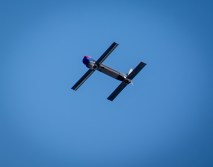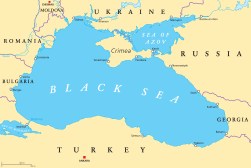Navy grappling with the future of its unmanned fleet
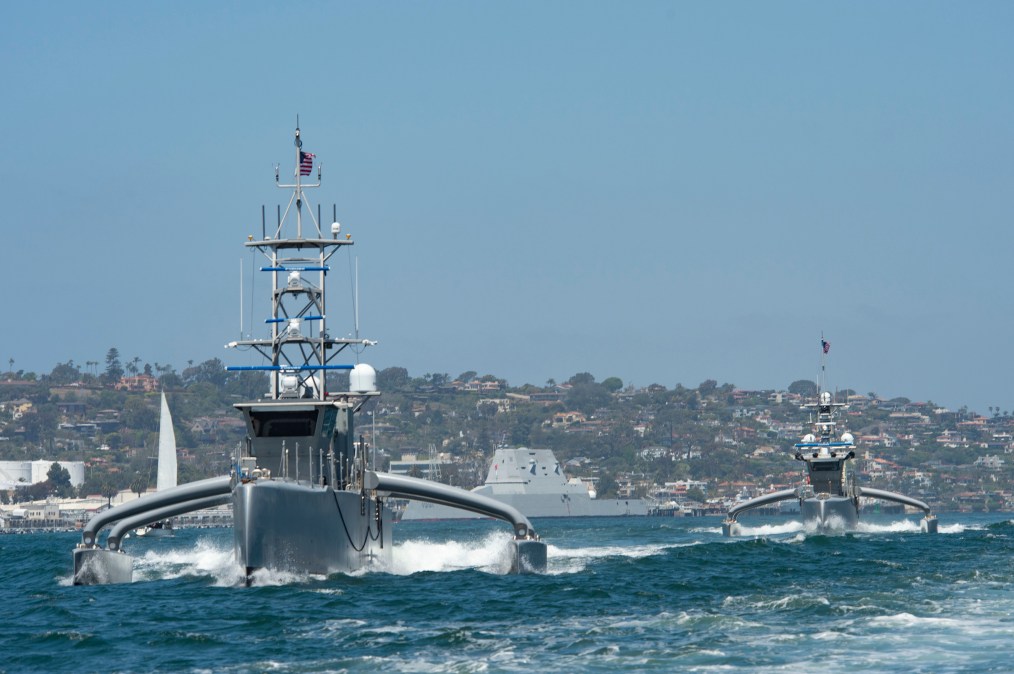
The Navy wants to create a “hybrid fleet” that includes a large number of robotics vessels to complement its manned ships, and it is laying the groundwork for such a transformation. However, its new shipbuilding plan and recent comments by senior officials indicate that the future of the unmanned force remains murky.
The service is touting the benefits of having cost-effective uncrewed maritime systems that could conduct a variety of missions — to include intelligence, surveillance, reconnaissance (ISR) and offensive strike — and keep sailors out of harm’s way.
Officials say such platforms will be an integral part of the Navy’s future warfighting team.
“Unmanned systems will increase lethality, capacity, survivability, operational tempo, deterrence, and operational readiness,” the Navy stated in its Unmanned Campaign Framework released last year.
“The question is not ‘if’ the Naval force will prioritize and leverage unmanned platforms and systems, but how quickly and efficiently, in resource constrained environments,” the document said.
However, the sea service still hasn’t figured out how many it will need in the long term and what mix of systems it wants.
The new shipbuilding plan
In April the Navy released a new 30-year shipbuilding plan shortly after submitting its fiscal 2023 budget request.
The plan offers narrow objective force sizes for its future manned battle force under various budget scenarios, and it provides detailed procurement profiles for the coming decades. However, long-term plans for unmanned surface vessels (USVs) and unmanned undersea vessels (UUVs) are less clear.
The document says the Navy will have anywhere from 89 to 149 unmanned maritime vessels by 2045, assuming no real budget growth, which could include some combination of medium unmanned surface vessels (MUSVs), large unmanned surface vessels (LUSVs), and extra-large unmanned undersea vessels (XLUUVs).
Projected force levels will be adjusted as the capabilities of unmanned platforms develop and are integrated into the battle force, according to the shipbuilding plan.
“As prototyping and experimentation retire technical and CONOPS [concept of operations] uncertainty, coupled with higher fidelity cost models, we expect that the objective force ranges will narrow,” it says.
Other documents released in recent years similarly offered broad objective force ranges for the unmanned fleet.
For example, a Future Naval Force Study delivered to Congress in 2020 during the Trump administration called for 81 to 153 USVs and 18 to 50 UUVs by 2045. A Biden administration shipbuilding plan released in June of last year called for 59 to 89 USVs and 18 to 51 UUVs.
The new long-term shipbuilding plan did break down how many USVs and UUVs, respectively, might be in the future fleet, or the approximate mix of MUSVs, LUSVs, XLUUVs and other robotic platforms.
In the near term at least, the picture is a little bit clearer.
The Navy’s fiscal 2023 budget request includes $104 million for research and development of medium unmanned surface vessels and $146.8 million for large unmanned surface vessels, as well as $181.6 million for “enabling capabilities.”
LUSVs are expected to be 200 feet to 300 feet in length and have full-load displacements of 1,000 tons to 2,000 tons — larger than a patrol craft and smaller than a frigate, according to the Congressional Research Service (CRS). Chief of Naval Operations Adm. Michael Gilday envisions them as strike platforms that could carry a “floating arsenal of weapons.”
MUSVs are expected to be 45 feet to 190 feet long, with displacements of roughly 500 tons — about the size of a patrol craft. They could be equipped with intelligence, surveillance and reconnaissance payloads and electronic warfare systems, according to CRS.
Additionally, the Navy is requesting $283.9 million for R&D of unmanned undersea vessels, including $116.9 million for the Orca extra-large UUV, $106.3 million for small and medium UUVs and associated payloads, and $60.7 million for supporting technologies.
XLUUVs are to be about 50 feet long, or approximately the size of a subway car, and could lay mines, among other potential mission sets, according to CRS. The Navy christened the first in-water “test asset system” for the Orca platform in April.
The sea service is also pursuing a variety of smaller systems that would likely never be included in the battle force count, such as the REMUS 300, which in March was selected as the next-generation UUV program of record. The system is man-portable and could be deployed from small boats for ISR missions or countermine operations, among other tasks.
In April the Department of Defense also announced plans to transfer mysterious “unmanned coastal defense vessels” to Ukraine that analysts say are likely small USVs, but the Pentagon has been tight-lipped about them.
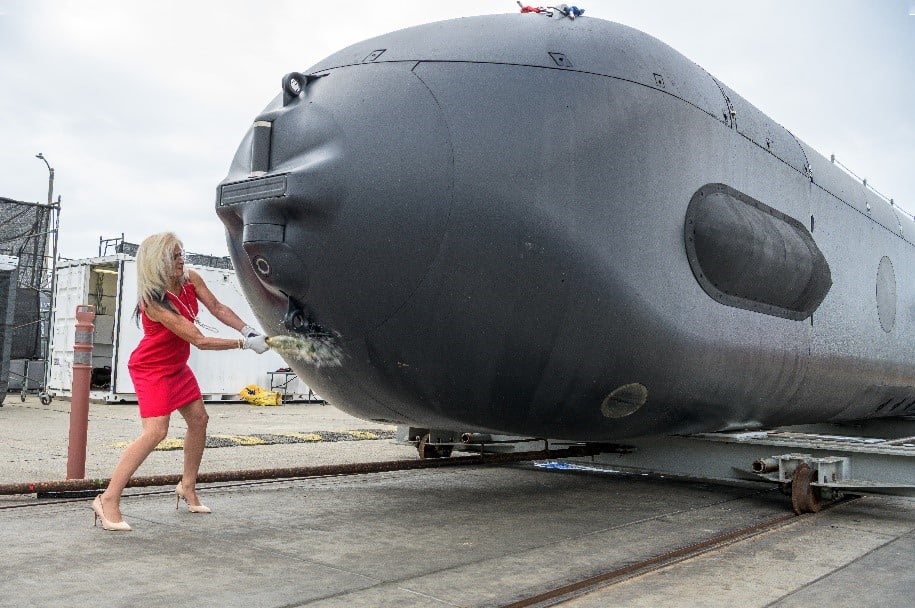
‘Still in their infancy’
Part of the reason the Navy isn’t on the precipice of buying large numbers of robotic ships is that these types of systems aren’t as far along in their technological readiness as unmanned aerial systems, which proliferated and became an iconic symbol during the post-9/11 wars.
“While the U.S. military has remotely operated uncrewed aerial vehicles for over three decades, uncrewed maritime systems are still in their infancy from both technical and operational perspectives,” the Government Accountability Office said in a report published in April.
“To execute its strategy, the Navy needs to make significant investments in the development of technologies to enable these uncrewed maritime systems to operate both autonomously (or semi-autonomously) as well as in conjunction with the existing fleet. As a result, the Navy is embarking on a robust effort intended to rapidly develop and field uncrewed maritime system prototypes and overcome technical challenges prior to acquiring these systems in significant numbers,” the GAO study said.
The Navy’s new shipbuilding plan acknowledges that new production platforms have developmental risks.
The Snakehead large displacement UUV program is an example. The fiscal 2023 budget request would eliminate funding for the program to the tune of $516.8 million across the future years defense program.
“Misalignment of Snakehead LDUUV design and procurement efforts with submarine hosting interfaces resulted in limited availability of host platforms to conduct Snakehead operations,” according to Navy budget documents. “Cost and schedule delays associated with LDUUV development and Virginia Class SSN [submarine] integration prohibited further investment.”
Building and integrating platforms isn’t the only challenge. Developing enabling technologies such as artificial intelligence and machine learning will be critical for enabling autonomous operations.
“We need to be more disciplined in describing what we need artificial intelligence to do, what type of machine learning do we actually need, how will those investments close our key operational problems, and how they’re linked to our concept of operations in terms of how we’re going to shoot how, we’re going to maneuver, how we’re going to resupply and how we’re going to defend in high-end conflict that could potentially be in the Pacific,” Vice Adm. Scott Conn, deputy chief of naval operations for warfighting requirements and capabilities, said in April at the annual Sea-Air-Space conference.
Speaking last month at the Center for Strategic and International Studies, Adm. Gilday said unmanned systems coupled with AI and other software have a lot of unrealized potential, but it’s difficult to come up with “a definitive number” for how many systems the Navy needs.
Additionally, the service still needs to make more headway with Project Overmatch, the Navy’s contribution to the Pentagon’s Joint All-Domain Command and Control (JADC2) concept, which aims to link the U.S. military’s sensors and shooters into a more unified communications network.
That effort is “getting after the C2 challenges that we need to resolve before we scale in a big kind of way with unmanned,” Gilday said.
Ships will need to have their own “tactical cloud” to handle data.
“That tactical cloud might be informed by a data link back in CONUS [the continental United States] or in Hawaii or wherever it might be. But at some point that ship … is likely to be cut off from communications and only have the data available that you have resident in your own tactical cloud, supplemented by your own sensors,” he said.
He continued: “And so I think, first and foremost … we have to have the ability from a mission command standpoint to leverage micro-processing and applications. And this is exactly what we’re trying to do with Overmatch in order to make the most use of that data locally.”
He continued: “And then I think the real key is the AI capabilities you’re going to use to leverage the data … We’re in a good path in terms of experimentation to work our way through that.”
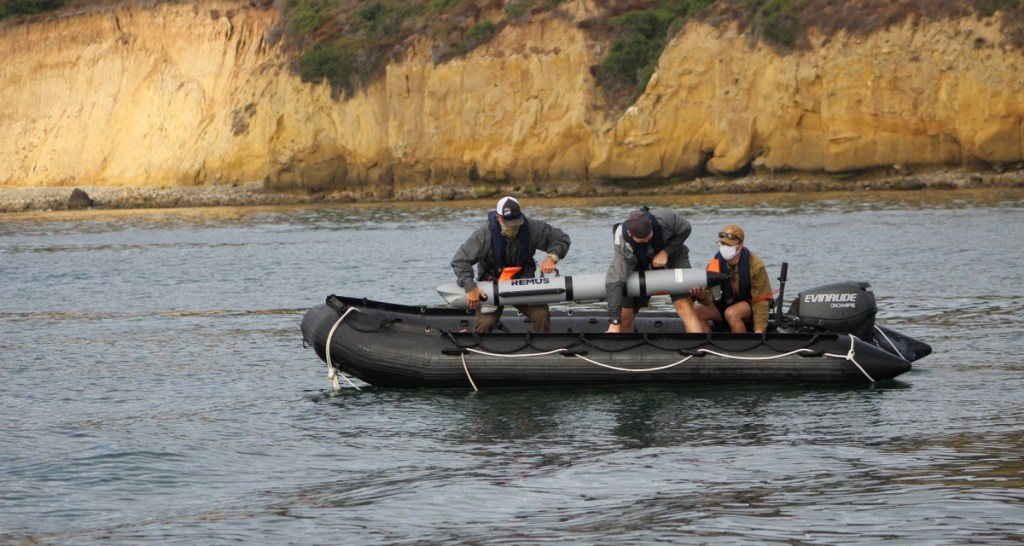
An ‘eye opening’ experience
The Navy in September of last year established an Unmanned Task Force to look at ways to solve operational challenges and inform acquisition strategies.
Around the same time, another task force, CTF-59, was set up with the Navy’s Fifth Fleet to try to accelerate AI solutions through operational experimentation with available unmanned systems and to look for ways to improve situational awareness.
A number of fleet exercises have also been conducted to explore the technology, including International Maritime Exercise 22. The event, which wrapped up in February, involved more than 80 robotic platforms of various types.
“We put unmanned systems in those exercises with our industry partners, with our allies, to iterate, to learn, to understand the capabilities [and] the gaps that we need to close on before we make the decision to scale,” Conn said.
“That is the type of environment that we need to continue to resource and to use because I’m a firm believer some of the really clear innovative solutions is going to come from the fleet. Give them the tools, let them iterate, let them learn, provide us in the Pentagon feedback,” he added.
The hope is that the unmanned task forces will reduce technical risks and make the Pentagon a more informed customer with respect to what it’s going to buy and the appropriate engineering paths and command-and-control frameworks before it starts deploying them.
The sea service is worried about screwing up, Gilday acknowledged, pointing to the failures of the Littoral Combat Ship program. The LCS have been plagued by technical problems and doubts about their survivability and utility in a conflict against advanced adversaries, and the Department of Defense is in the process of retiring many of them even though they’re relatively new additions to the fleet.
“I don’t want to wake up in 15 years and say we bought the wrong kind of LUSV with the wrong engineering plan,” Gilday said.
The Navy wants to “build a little, test a little, learn a lot.”
Based on what’s been learned so far, Gilday recently called into question whether the Navy even needs a medium unmanned surface vessel, despite the fact that the service’s 2023 budget request includes $104 million in R&D funding for the technology.
“The way we’re going with the unmanned task force that’s tied together acquisition specialists, requirements folks, scientists from the Navy research labs, and also the fleet with CTF-59 in terms of real-time exercising, experimenting and developing CONOPS — it’s been a powerful, eye-opening, awakening experience for us,” he said.
In the future “I don’t know if we’ll have a medium unmanned or not,” he added. “The stuff that [Vice Adm. Brad Cooper] is doing right now with CTF-59 and using small unmanned on the sea, in the air to sense the environment and make sense of it in order to yield a common operational picture for allies and partners, as well as the Fifth Fleet headquarters, has changed my thinking on the direction of unmanned.”
The Navy may be able to close capability gaps with smaller, expendable robotic systems, he suggested.

‘Minimally manned’
The Navy has been testing the ability of various vessels, including large Sea Hunter prototypes, to sail long distances without humans onboard. Such systems now have more than 40,000 nautical miles of “autonomous travel” under their belt, according to Gilday.
But navigation is just one piece of the operational autonomy puzzle that needs to be solved for robotic ships to take on a bigger role.
“To send an unmanned out into the ocean with a mission, and to expect that unmanned to come back and salute and say ‘mission complete’ — that’s a whole different problem set,” Gilday noted. “That’s something that we’re working on, but quite frankly that’s going to be a journey for us.”
There could be a transition period for platforms like LUSVs during which some sailors would be onboard to make sure things don’t go awry.
“I use the word ‘unmanned’ perhaps too often. I think that we’re going to be in an evolutionary path here with unmanned, and I think that’s likely to involve minimally manned [ships] for a while,” he said.
Gilday sees a possibility of deploying LUSVs with strike groups and amphibious ready groups beginning in the late 2020s, but he noted they don’t necessarily have to be completely uninhabited by sailors at that time.
A view from the Hill
The White House and Navy can propose buying whatever ships they want, but Congress has the power of the purse and can choose to not go along with their plans.
While lawmakers recognize the usefulness of unmanned technology, some are worried about embracing it too quickly.
“It’s hard enough to operate a ship and the mechanical systems at sea with a crew. And we have tried even with a manned ship to scale back and do smart ship technology and do different things to reduce manning — and we failed at that every time. How are we ever going to actually field the technology where we can operate this [unmanned] thing independently for extended periods of time?” said Vice Chair of the House Armed Services Committee Rep. Elaine Luria, D-Va., a retired Navy surface warfare officer.
Concepts of operations for unmanned vessels haven’t been sufficiently fleshed out, she said at the Surface Navy Association’s annual conference earlier this year.
“There’s kind of just a lot of different things out there that have been proposed. And it’s not very clear kind of which direction the Navy wants to go, what technology they want to either replace or augment with these unmanned vessels. And so that’s why I remain somewhat skeptical,” she said.
Luria is particularly opposed to efforts to decommission manned ships to free up money to invest in new technologies like unmanned systems that aren’t yet ready for prime time.
“We need to make investments in developing the technology to implement it when it’s mature, but that should not be at the expense of” the current fleet, she said. “We can’t just get rid of our fleet today to jump on a technology that’s not mature yet.”
Gilday noted that there’s wariness on the Hill about robotic ships.
“Congress is not going to let us move that quickly anyway, so we are trying to prove ourselves in an evolutionary, deliberate, informed kind of way,” he said.

No risk-free path
The Government Accountability Office says the Navy is at risk of failing to achieve its strategic goals if it doesn’t improve how it’s managing its uncrewed maritime systems portfolio.
“If it continues with its current approach, the Navy is less likely to achieve its objectives,” the watchdog warned in its report released last month.
GAO issued a list of recommendations for the sea service, including providing cost estimates that include the full scope of known costs to operate uncrewed systems, reorganizing oversight of the uncrewed maritime systems portfolio, and offering more details about measures and metrics for achieving strategic objectives.
Other recommendations include: developing evaluation criteria for assessing each uncrewed prototype effort’s readiness to transition to an acquisition program; putting together a master planning schedule to include each uncrewed maritime system effort; and revising prototyping plans for each uncrewed maritime system to incorporate how the Navy plans to use its prototyping efforts to mature technologies to achieve top level requirements as well as develop certifications that apply to uncrewed maritime systems prior to investment decisions.
The Navy generally concurred with the recommendations, but its planned actions do not fully address all of them, according to GAO.
Tom Shugart, a defense analyst with the Center for a New American Security and a retired submarine warfare officer, said the Navy’s current approach to unmanned maritime systems is about right, but it needs to be prepared to move faster.
“Once the Navy does sort of get these things figured out, I think the scale needs to be turned up pretty rapidly. Because the nature of the challenge that we’re seeing out there in the western Pacific really calls for a pretty dramatic and urgent action to try to address the challenge of the PLA [China’s military] and in particular the PLA Navy,” he said.
When the Navy is ready to ramp up, industrial capacity isn’t expected to be a hindrance, the new shipbuilding plan suggested.
“The unmanned surface and undersea vessels described in this plan can be supported by the existing shipbuilding industrial base, providing opportunities for existing shipyards, existing boat and craft builders, and the potential for new entrants,” the document says.
There’s no risk-free path to developing an unmanned fleet, Shugart noted.
“I get it that there are folks that are hesitant to invest a lot of money into things that haven’t been fully proven yet,” he said. “But not investing and not moving at the pace we need to has its own operational and strategic risks of just leaving an unanswered challenge out there.”
How many uncrewed systems the Navy needs and decides to procure will depend on a number of factors and will be shaped by requirements and the amount of resources available for investment.
“The requirements part I would imagine hasn’t really been fully figured out yet. They’re still working on the CONOPS, the concepts of operations … which helps you figure out what you can and want to do with these things,” Shugart said.
Operational plans for the systems, informed by threat assessments, need to be developed to help officials determine how many they will need to achieve operational objectives.
Given the uncertainties at this point, it makes sense that the Navy’s shipbuilding plan didn’t offer a narrower range for the number of USVs and UUVs that it projects will be in its future force structure, or provide more granular details, he said.
It could be years before the sea service is able to state more precisely how many robotic ships it plans to buy.
“To have things really nailed down to one ‘here’s what we need’ number for unmanned systems — that would be unrealistic anytime real soon,” Shugart said.

